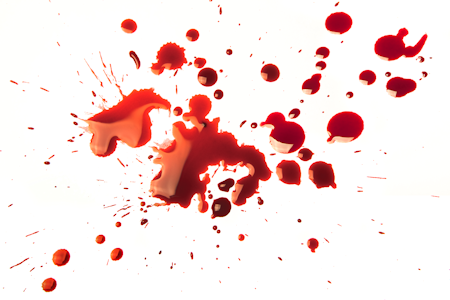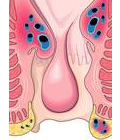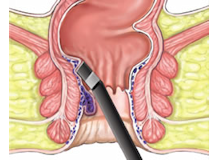Internal Hemorrhoids
 Internal hemorrhoids occur inside the rectum and not in the anal cavity and they often go unnoticed. However, patients with internal hemorrhoids may notice the presence of blood in their stool, on toilet paper or in the toilet bowl. Pain is generally not associated with this type of hemorrhoids as there are no pain receptors in the rectum itself.
Internal hemorrhoids occur inside the rectum and not in the anal cavity and they often go unnoticed. However, patients with internal hemorrhoids may notice the presence of blood in their stool, on toilet paper or in the toilet bowl. Pain is generally not associated with this type of hemorrhoids as there are no pain receptors in the rectum itself.
 Why bleeding is considered one of the internal hemorrhoids symptoms is because the hemorrhoids can become irritated. If left untreated, they can lead to two more severe types of hemorrhoids – prolapsed and strangulated hemorrhoids. Prolapsed hemorrhoids are distended to the point where they protrude out of the anus. If and when the sphincter muscle goes into a spasm, it can trap a prolapsed hemorrhoid outside the anal opening – cutting off the blood supply to become a strangulated hemorrhoid.
Why bleeding is considered one of the internal hemorrhoids symptoms is because the hemorrhoids can become irritated. If left untreated, they can lead to two more severe types of hemorrhoids – prolapsed and strangulated hemorrhoids. Prolapsed hemorrhoids are distended to the point where they protrude out of the anus. If and when the sphincter muscle goes into a spasm, it can trap a prolapsed hemorrhoid outside the anal opening – cutting off the blood supply to become a strangulated hemorrhoid.
Internal hemorrhoids are classified using four different degrees: Grade 1, Grade 2, Grade 3 and Grade 4. Most of them are classified as Grade 1 hemorrhoids. Within this grade, the hemorrhoid may be completely unnoticed although it may bleed when irritated. Grade 2 hemorrhoids do prolapse but then they reduce in size fairly quickly. Grade 3 internal hemorrhoids prolapse but they do not reduce immediately. This type of hemorrhoid needs to be manually reduced. Grade 4 hemorrhoids are the most severe as they prolapse but cannot typically be manually reduced.
Bleeding Internal Hemorrhoids Treatment Options
 Internal hemorrhoids treatment options vary, depending upon the classification or grade. It is often recommended that sufferers increase their intake of dietary fiber. This helps to soften the stools and to prevent the internal type of hemorrhoids from being traumatized. It is also advisable not to use strong laxatives as they can aggravate the condition. However, drinking plenty of water and eating 20 to 30 grams of fiber daily along with other optional natural hemorrhoid treatment methods can help to control the inflammation.
Internal hemorrhoids treatment options vary, depending upon the classification or grade. It is often recommended that sufferers increase their intake of dietary fiber. This helps to soften the stools and to prevent the internal type of hemorrhoids from being traumatized. It is also advisable not to use strong laxatives as they can aggravate the condition. However, drinking plenty of water and eating 20 to 30 grams of fiber daily along with other optional natural hemorrhoid treatment methods can help to control the inflammation.
A rather common internal hemorrhoids treatment consists of using topical preparations which are administered into the anal cavity through the use of suppositories and pile pipes. These hemorrhoid creams, gels and ointments contain a combination of analgesics, antiseptics and other compounds which help to shrink the affected veins. Protectant topicals such as glycerin, lanolin and cocoa butter also can be used. These preparations form a protective barrier over the swollen blood vessels to stop the stool from coming in contact with the skin.
 One of the oldest internal hemorrhoids treatment options used is sclerotherapy. With this procedure, phenol or quinine urea is injected into the bulging vein to reduce swelling and irritation. Rubber band ligation is another common treatment used. This involves applying a tight rubber band to the base of the hemorrhoid so that the blood supply is cut off. Surgical procedures are not used on any other type of internal hemorrhoids other than those considered Grade 4 due to the risks involved with general anesthesia and pain involved with recovering from surgery. If surgery is needed because the hemorrhoids are large and very painful, a surgeon will surgically remove the hemorrhoids with either a scalpel or laser wherein the incision is closed with stitches.
One of the oldest internal hemorrhoids treatment options used is sclerotherapy. With this procedure, phenol or quinine urea is injected into the bulging vein to reduce swelling and irritation. Rubber band ligation is another common treatment used. This involves applying a tight rubber band to the base of the hemorrhoid so that the blood supply is cut off. Surgical procedures are not used on any other type of internal hemorrhoids other than those considered Grade 4 due to the risks involved with general anesthesia and pain involved with recovering from surgery. If surgery is needed because the hemorrhoids are large and very painful, a surgeon will surgically remove the hemorrhoids with either a scalpel or laser wherein the incision is closed with stitches.
Any patient who thinks he or she has this type of hemorrhoids should sit down with their doctor to discuss the internal hemorrhoids symptoms. This also will give the patient the opportunity to learn about the internal hemorrhoids treatments options which are available. The type of treatment used will depend upon a patient’s age, overall health and the severity of the hemorrhoids.
